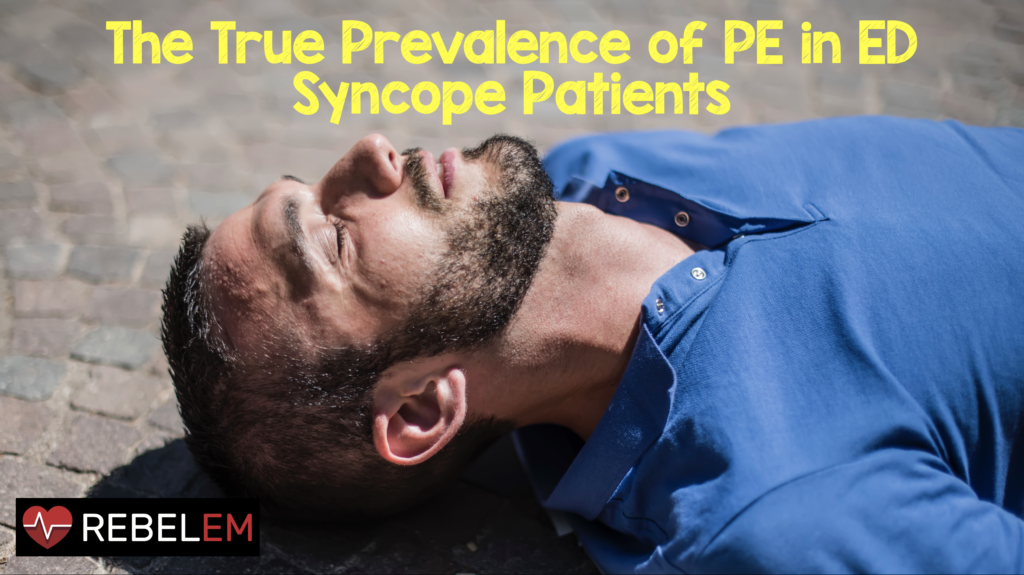 Background: Syncope, defined as a transient loss of consciousness with a complete recovery, is a common ED presentation. There are numerous causes of syncope ranging from the relatively benign (eg vasovagal syncope) to the potentially life-threatening (eg dysrhythmia, ectopic pregnancy, aortic dissection). Among the life-threatening diagnoses is pulmonary embolism (PE). PE is a common cause of sudden, unexpected, non-traumatic death and, syncope in the setting of PE portends poor 30-day outcomes (Roncon 2018). What is not well known is how often ED presentations of syncope are the result of PE. A study in 2016 demonstrated a 17.3% rate of PE in first time syncope presenting to the ED but, had numerous significant biases and limitations (Prandoni 2016). Ultimately, this study is unlikely to reflect the reality of ED syncope cases and lacks external validity. Incorporating the PESIT trial data into clinical assessment would lead to a profound increase in PE evaluation without adding significant benefit. Additional clinical data demonstrating the true prevalence of PE in syncope patients is needed to confirm these suspicions.
Background: Syncope, defined as a transient loss of consciousness with a complete recovery, is a common ED presentation. There are numerous causes of syncope ranging from the relatively benign (eg vasovagal syncope) to the potentially life-threatening (eg dysrhythmia, ectopic pregnancy, aortic dissection). Among the life-threatening diagnoses is pulmonary embolism (PE). PE is a common cause of sudden, unexpected, non-traumatic death and, syncope in the setting of PE portends poor 30-day outcomes (Roncon 2018). What is not well known is how often ED presentations of syncope are the result of PE. A study in 2016 demonstrated a 17.3% rate of PE in first time syncope presenting to the ED but, had numerous significant biases and limitations (Prandoni 2016). Ultimately, this study is unlikely to reflect the reality of ED syncope cases and lacks external validity. Incorporating the PESIT trial data into clinical assessment would lead to a profound increase in PE evaluation without adding significant benefit. Additional clinical data demonstrating the true prevalence of PE in syncope patients is needed to confirm these suspicions.
Article: Thiruganasambandamoorthy V et al. Prevalence of Pulmonary Embolism Among Emergency Department Patients with Syncope: A Multicenter Prospective Cohort Study. Ann Emerg Med 2019. PMID: 30691921
Clinical Question: What is the prevalence of PE among ED patients presenting with syncope?
Population: Patients combined from two separate studies. The Canadian study enrolled patients > 16 years of age presenting with syncope while the US study enrolled patients > 60 years of age presenting with syncope or near-syncope.
Primary Outcome: Identification of PE within 30 days of the index ED visit (including at the initial presentation)
Design: Prospective, multicenter, cohort study conducted across 17 EDs in Canada and the US. This study combined data from 2 separate studies looking to identify patients with serious causes of syncope.
Excluded: “Patients who did not experience true syncope (prolonged loss of consciousness >5 minutes, change in their mental status from baseline after the syncope, or obvious witnessed seizure or head trauma causing loss of consciousness),” those unable to provide proper history due to alcohol intoxication, illicit drug use, or language barriers. Additionally, the Canadian study excluded patients with near-syncope.
Primary Results:
-
- 9374 patients prospectively enrolled in the two studies
- Lost to follow-up: 273 (2.9%)
- Withdrew from study: 10 (0.1%)
- Canadian study enrollment: 5415 (59.6%)
- US study enrollment: 3676 (4.4%)
- Investigated for PE on initial presentation: 547 (6.0%)
- 9374 patients prospectively enrolled in the two studies
Critical Findings:
- Serious underlying condition identified or death at 30-days
- 9.6% (874/9091)
- Dysrhythmias: 5.9%
- Myocardial Infarction: 1.3%
- Serious Structural Heart Disease: 0.9%
- Aortic Dissection: < 0.1%
- Subarachnoid Hemorrhage: 0.1%
- Cardiac Procedural Intervention: 3.3%
- PE at 30-days (primary outcome): 0.6% (56/9091)
- 9.6% (874/9091)

- PE leading to death: 4/9091 (.04%)
- Admitted patients with PE
- 39.1% of patients in cohort were admitted
- 1.2% of these patients were diagnosed with PE
Strengths:
- Authors ask a clinically important question further investigating the results of the highly discussed PESIT study
- Study is multinational and multi center and contains patients from a wide range of ages
- This is the largest prospective study to date with systematic follow-up of patients presenting to the ED with syncope
- Potentially eligible patients with a presenting complaint suggestive of syncope who were not eligible or who were missed were identified by trained research assistants through review of all ED visits during the study period
- PE prevalence was similar in both cohorts (< 1%)
- Follow up was excellent with 97% of patients with recorded 30-day outcomes
- Enrollment was consecutive
- PE diagnosis adjudicated as clinically relevant and the likely cause of the index syncope. Adjudication committee was blinded to all study data except study outcomes
- Investigations of PE were at the discretion of the provider (Pragmatic approach. May also be considered a limitation (verification bias))
- Follow up for the Canadian study was with a structured telephone interview as well as reviewing health records of all local hospitals, death records in Ontario and review of an administrative health database.
- Follow up for the US study was with a structured 30-day telephone interview and hospital records at non-study site hospitals were reviewed when visits identified by interview
- Independent review of a subset of cases in the US study was performed and found 100% sensitivity for identification of serious clinical outcomes and inter-rater reliability was high (kappa = 0.8)
Limitations:
- Design and inclusion criteria of the two combined studies was not the same (see discussion below)
- All patients who presented were not evaluated for PE so the rate of PE may (and likely is) higher than what is reported
- D-dimer test results were available only for the Canadian cohort
- D-Dimer test results were according to the conventional local cut point of 500 ng/Ml and did not adjust this cut point according to the patients age
- Small number of patients with cancer (383/9091 ~ 4.2%) making it difficult to draw any conclusions in this patient population
- No pulmonary embolism specific risk factors such as recent immobilization or surgery were collected, therefore it is impossible to decide what factors were most helpful in generating a high-risk subgroup
- Although PE as adjudicated as clinically relevant, location of the PE was not recorded
- It is impossible to tell if PE diagnosed after index ED visit/hospitalization were present during the initial visit or were events that developed after discharge (i.e. they may not have been missed diagnoses)
- Follow up system (telephone interview) was subject to recall bias
Discussion:
- This article is the first high-quality data set published since the PESIT trial and demonstrates what most emergency clinicians already knew – data from the PESIT trial was an extreme outlier
- This is an unusual publication as it combines data from studies that were undertaken for the same reason but with different populations included. The authors explicitly state that their reason for combining the data was to “help contextualize the Pulmonary Embolism in Syncope Italian Trial (PESIT) findings.”
- The two combined studies were quite different. The authors state: “The 2 studies differed in 3 important ways. First, the Canadian study enrolled any adult patient (16 years) presenting with syncope, whereas the US study enrolled only older patients (60 years) with syncope. Second, the Canadian study excluded patients with presyncope or near syncope (imminent sensation of passing out with loss of consciousness), whereas the US study included these patients. Third, the Canadian study collected data on history of syncope, whereas the US study collected only history of syncope in the past year. We prespecified subgroup analyses by country, age, and true syncope (excluding patients with presyncope) to test the validity of data pooling.”
- All patients in the study were not evaluated for PE as this would neither be pragmatic or ethical. However, the study asked a more important question than whether there was a PE or not – it asked is there a clinically important PE?
- Despite an older patient population (Median age 66 years), the PE prevalence was <1% and consistent when evaluated in subgroup analysis
Authors Conclusions: “The prevalence of pulmonary embolism is very low among ED patients with syncope, including those hospitalized after syncope. Although an underlying pulmonary embolism may cause syncope, clinicians should be cautious about indiscriminate investigations for pulmonary embolism.”
Our Conclusions: We agree with the authors. PE is an uncommon diagnosis among patients with true syncope (i.e. loss of consciousness with return to baseline status afterwards). Investigation of PE in patients with syncope should be guided by the patient’s history and physical and not become routine in the absence of symptoms, signs or risk factors.
Potential to Impact Current Practice: This study further buries the PESIT study findings. A number of clinicians have given thorough critiques of this study, but this data set puts the idea that 1 in 6 patients presenting with syncope has a PE to rest.
Bottom Line: PE can cause syncope and patients with PE who have syncope or near syncope are at a higher risk for bad outcomes. PE should be investigated as a cause of syncope when the presentation gives signs and symptoms of PE, but it should not be a routine part of syncope evaluation.
For More on This Topic Checkout:
- EM Nerd: The Case of the Incidental Bystander Continues
- REBEL EM: The PESIT Trial: Do All Patients with 1st Time Syncope Need a Pulmonary Embolism Workup?
- Core EM: Episode 73 – PE in Syncope Study
References:
- Roncon L et al. Impact of Syncope and Pre-Syncope on Short-Term Mortality in Patients with Acute Pulmonary Embolism. Eur J Intern Med 2018; 54: 27-33. PMID: 29655808
- Prandoni P, Lensing AW, Prins MH, et al. Prevalence of Pulmonary Embolism among Patients Hospitalized for Syncope. N Engl J Med. 2016;375(16):1524-1531. PMID: 27797317
Post Peer Reviewed By: Salim R. Rezaie, MD (Twitter: @srrezaie)



